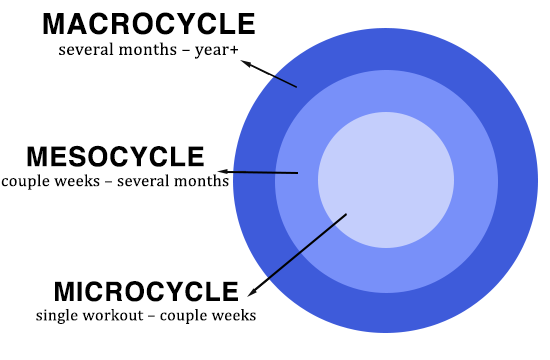
Smash Through Lifting Plateaus With Periodization Training
By Pamela Hernandez
Getting into a routine was tough for you, but you did it. You were lifting weights every Monday, Wednesday, and Friday. You were keeping your heart rate up with regular cardio. And you were seeing results — until recently.
Suddenly, no matter how hard you push yourself or how many extra reps and sets you add to each workout, your sessions have become stale and ineffective.
There's no way around it. You've hit a plateau.
Let's discuss one possible reason why: Your training program lacks periodization.
Improve endurance and enhance strength with the combination of beta-alanine and creatine in LADDER Pre-Workout!
.
What Is Periodization?
Periodization is a strategy for varying a training program over time to achieve a desired result, such as increased muscle growth or power.

The overall program is referred to as a macrocycle, which typically lasts from several months to a year — although it can extend up to four years if you're an Olympian or Olympic hopeful.
Within each macrocycle, there are two or more training blocks, or mesocycles, each of which lasts from a couple of weeks to several months and focuses on a specific goal, like:
- Muscle growth
- Strength
- Power
Each mesocycle is further divided into microcycles that can span a single workout or a couple of weeks.
The difference between periodization and simply switching up your workout when you get bored is that the former is pre-planned, progressive, and strategic. You're shifting training goals and methods at specific intervals in a goal-oriented training calendar — in other words, periodization is all about the long game.
.
Different Methods of Periodization
There are two primary kinds of periodization: linear and nonlinear (also called undulating).
Linear periodization
The more traditional of the two types, linear means that you lift progressively heavier weights for progressively fewer reps during the course of the macrocycle.

“I generally keep every phase to four weeks," says physiologist and certified personal trainer Tamara Grand, Ph.D. “That provides enough time to learn the exercises, improve performance, and increase the load before boredom sets in."
The classic linear training plan involves four mesocycles:
- Hypertrophy and endurance, which focuses on low-to-moderate weight and high volume (think 10 to 20 reps per set). The goal of this phase is to build lean mass and muscular endurance.
- Basic strength, which builds just that, using heavy weights and moderate volume (four to eight reps per set).
- The power phase comes next, and involves explosive movements and low volume (one to five reps per set).
- The transition period typically entails cutting way back on training intensity and volume or engaging in active rest — like low-intensity sports or recreational activities — to allow the body to recover before beginning the next macrocycle.
The benefit of following a linear periodization program is that it allows your body to adapt gradually, reducing the risk of overtraining and burnout — which is why trainers often use this approach for beginners.
Undulating periodization
Nonlinear periodization — also called undulating periodization — is another option typically changes the training load and volume from workout to workout or week to week.
To give you a better idea of what this looks like, we asked Grand to sketch out an overview of a week's worth of workouts. Here's what she came up with.
- Monday: Strength/power focus with heavy weight, low reps (four to six per set), and three to five sets per exercise. The workout is ideally built around a big compound movement like the squat or bench press.
- Wednesday: Endurance focus with low weight, high reps (15 to 20 per set), and three to six sets per exercise. Total body moves like the dumbbell squat to press and bodyweight moves like the walking lunge are smart options for this workout.
- Friday: Hypertrophy focus with moderate weight, moderate reps (eight to 12 per set), and three to five sets per exercise. A mix of compound movements and isolation exercises like the triceps extension and biceps curl belong in this workout.
In this example, each training week is a microcycle repeated four times to complete one mesocycle.
Each mesocycle, you'd change the exercise selection and workout order — so after four weeks of doing strength on Monday, endurance on Wednesday, and hypertrophy on Friday, you might do hypertrophy on Monday, strength on Wednesday, and endurance on Friday. Complete four mesocycles to finish one macrocycle.
.
Which Periodization Method Is Best?
That depends on who you ask.
Some research suggests that suggests that linear periodization may be more effective for increasing strength while undulating periodization is better for developing muscular endurance.
Other research suggests that both strategies may be equally effective — especially during the early phases of training.
If you have the resources, you can speak with a professional about your own goals and issues to help you get over your plateau. Either way, if your workout has gotten static, mixing things up is always a good idea!



